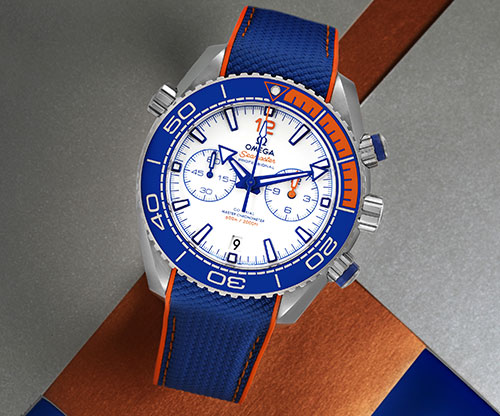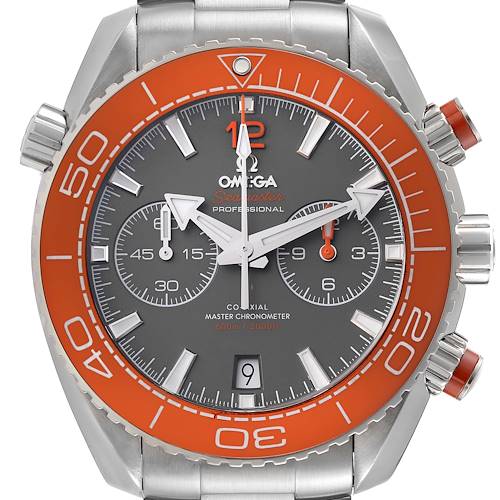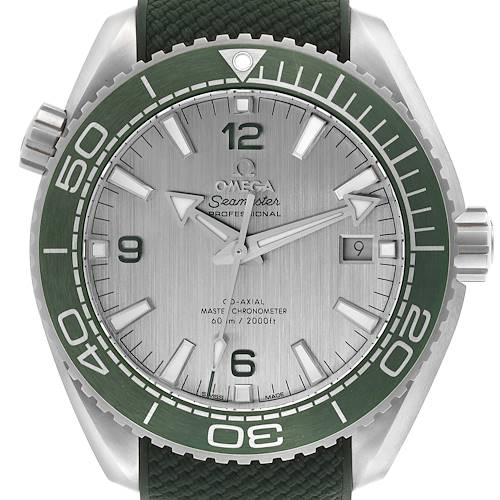- CALL US (404) 814-1814
- LIVE SUPPORT
- EMAIL US
-
WISHLIST (0)
-
CART(0)
Men's Planet Ocean | Grey | Omega Watch Collection
2 MATCHES FOUND
Omega Planet Ocean Collection

Launched in 2005, the Omega Planet Ocean is a relatively new addition to the Omega family. It joined the Omega Seamaster collection as a line of watches for professional and recreational divers, merging extraordinary waterproof capabilities and creative design.
The Omega Planet Ocean’s aggressively sporty look, combined with novel materials, state-of-the-art movements, and various evolutions, have made it the choice sports watch not just of divers, but of the jet-set and watch collecting community. While it boasts of 600m water resistance and anti-magnetic properties, it’s never too serious in its design – with a wide range of colors, materials, and straps on offer, the Planet Ocean is actually a fun and approachable watch.
Equipped with state-of-the-art movements, and an avenue for Omega’s best marketing collaborations, it’s no surprise that the Planet Ocean has become one of the brand’s best-selling lines. Explore our collection of Omega Seamaster Planet Ocean watches at SwissWatchExpo.com.
A BRIEF HISTORY OF THE OMEGA PLANET OCEAN
Omega has a rich legacy of ocean exploration, beginning with the Marine, its first commercially available diver’s watch introduced in 1932. In 1948, as part of Omega’s 100th anniversary, the Omega Seamaster was launched, marking the beginnings of its longest running product line.
In the early 2000s, Omega sought to build on the Seamaster collection with a watch that can be used for greater depths and prolonged diving periods. Inspired by the ref 165.024 from 1967, the Omega Planet Ocean took the form of a robust part-round, part-tonneau shaped watch, with a greater water resistance of 600m, and a helium escape valve to aid in decompression during saturation dives.
The first generation of Omega Planet Ocean watches can be easily distinguished from newer versions. They began with aluminum bezel inserts and solid metal case backs with Omega's signature Hippocampus (seahorse) motif engraved. These watches were also powered by the caliber 2500, which was largely based on the ETA 2892-A2.
Newer generations received a couple of upgrades: the in-house caliber 8500 designed from the ground up with a Co-Axial escapement, and a sapphire crystal display case back which allows the wearer to see the workhorse movement inside.
Ceramic has also played an important role in the Omega Planet Ocean’s evolution. It was in 2012 that the aluminum unidirectional bezel was upgraded to scratch-resistant ceramic, and by 2016, Omega would unveil the Planet Ocean 600M Deep Black – the first real dive watch made exclusively from the material. Even the crown, dial, and helium escape valve were made of ceramic.
Throughout its 17 year history, the Omega Planet Ocean has undergone numerous changes and improvements, never once missing the essence of the collection – that of robust and capable watches, with a fun and stylish vibe.
ABOUT THE OMEGA PLANET OCEAN COLLECTION
Introduced in 2005, the Omega Planet Ocean was positioned as a stylish, luxury offering within the Seamaster line, paired with extraordinary waterproof capabilities. These qualities, combined with a versatile design and striking colorful branding, gave Omega another winner on their hands.
From just 3 models, the Planet Ocean line has grown to more than a hundred variations. Here are the different types of Planet Ocean watches:
First Generation (2005)
With a water resistance of 600m, the Planet Ocean comes in between the Seamaster Diver 300m and the PloProf 1200m. It was unveiled as a modern dive watch that also looks good enough for everyday, all-occasion use.
The first collection was available in two sizes: 42mm and 45.5mm. Both were equipped with aluminum unidirectional bezels, and a Helium Escape Valve for saturation diving. In 2006, Omega added the Planet Ocean Chronograph to the collection.
Colors: orange and black bezel
Bracelet: steel, rubber or leather
Movement: Caliber 2500 / Caliber 3313 (for chronograph)
LiquidMetal (2009)
Omega has been known to test innovations on the Planet Ocean range before going full-scale. In 2009, Omega introduced the LiquidMetal to the market through the limited edition Omega Planet Ocean ref. 222.30.42.20.01.001.
LiquidMetal is a malleable protective alloy applied over the ceramic bezel. Its purpose is to protect the ceramic from discoloration, to strengthen the material, and also to fill the recessed numbers on the bezel, where dirt can sometimes accumulate.
Second Generation (2011)
Omega knew that in order to compete with the likes of the Rolex Submariner, it had to constantly improve. Five years after its launch, the Planet Ocean was equipped with a new movement and a number of aesthetic improvements.
Caliber 2500 was replaced with Caliber 8500, which adopts the use of a silicon escapement and hairspring, thus extending its power reserve to 60 hours. It also allows for an independent hour hand and finally made way for an exhibition caseback (versus the steel caseback of the first generation). Noticeable aesthetic changes were also applied:
Case size: introduction of a 37.mm case size in addition to 42 and 45.5mm
Color ways: blue and white bezels and dials, in addition to black and orange
Metals: they also offered a Titanium model, in addition to stainless steel
Larger and more detailed indices, hour markers, and Seamaster logo
In some models, they also applied glossy dials and the LiquidMetal bezel
This generation of Omega Planet Ocean are considered the transitional models, where Omega tested elements that would make a more successful design language for the brand.
Colors: orange and black, blue and white bezels
Metals: stainless steel, titanium, and rose gold (by 2012)
Bracelet: steel, rubber or leather
Movement: Caliber 8500
Omega Planet Ocean GMT (2013)
In 2013, Omega introduced the GMT function to the Planet Ocean line. The Planet Ocean GMT features an independently adjustable hand that works with a 24-hour bezel and a new case size measuring 43.5mm.
It follows the design language of the Planet Ocean line, with a few enhancements to help distinguish the GMT function: an orange tipped GMT hour hand and 24-hour bezel markers, as well as an orange “GMT” line below the Seamaster text on the dial, in lieu of “Professional”.
Colors: black and white, orange and blue bezels
Metals: stainless steel
Bracelet: steel, rubber or leather
Movement: Caliber 8500
Third Generation (2016)
With the LiquidMetal bezel fully integrated into the Planet Ocean line, Omega upped the ante with the third generation design. This time, they combined LiquidMetal with galvanized rubber on the bezel, creating a look that’s striking, without the shine.
The black LiquidMetal bezel comes with a 15-minute scale that’s made of orange galvanized rubber. The dial was also changed from matte to polished black ceramic. The effect is a contrast of textures, and if the goal is to keep things interesting, Omega was successful in doing so.
Of course, Omega also went beyond aesthetics and made technological improvements:
Movement: Caliber 8500 was replaced with Caliber 8900. The first Master Chronometer movement from Omega, it’s accurate between 0 to +5 seconds per day, and is also magnetic resistant up to 15,000 gauss.
Bracelet: the bracelet was also refined to fit better on the wrist, to keep the watch from falling past the lugs.
In 14 years, Omega has created three major generations of the Omega Planet Ocean, culminating in three main models – Planet Ocean, Planet Ocean GMT, and Planet Ocean Chronograph.
Limited Editions
As one would expect from Omega, there are a myriad of special editions and collaborations under the Planet Ocean line. Some of the best known examples have revolved around the Olympic Games, and the world’s most accomplished Olympian, Michael Phelps.
Aside from these sport-related collaborations, the Planet Ocean collection has also included limited-edition James Bond models.
Omega Planet Ocean Ultra Deep (2022)
The Omega Planet Ocean maintained a standard water resistance of 600m (2,000 feet) since 2005. In 2022, a groundbreaking addition was introduced – the Planet Ocean Ultra Deep, a collection of watches water resistant to 6,000m (20,000 feet), and which also meet the ISO 6425:2018 standard for saturation diver’s watches.
The collection began as a series of prototypes tested during the Five Deeps Expedition in 2019, where the pieces reached the deepest place on Earth.
The Omega Planet Ocean may have a short history, but it has proven itself as a versatile line of watches that gets better with time.
OMEGA PLANET OCEAN REFERENCE NUMBERS
Omega uses a 14-digit product identification code (PIC for short) to document their models.
The PIC can be broken down as follows: AAA.BB.CC.DD.EE.FFF
AAA – the first three digits denote the collection or family of watches. Below are the respective numbers for the Seamaster collections:
| 210 / 212 | Seamaster Diver 300M |
| 215 | Seamaster Planet Ocean 600M |
| 220 | Seamaster Aqua Terra/Railmaster |
| 225 | Seamaster Bullhead |
| 227 | Seamaster PloProf |
| 233 / 234 | Seamaster 300 |
| 511 | Seamaster 1948 editions |
BB – The fourth and fifth digits represent the case and the strap or bracelet material; For example, 10 means the watch comes in a stainless steel case paired with a steel bracelet.
| 10 | Steel case and bracelet |
| 11 | Steel + Other metal |
| 12 | Steel + Non-metal |
| 13 | Steel + Non-metal (CITES) |
| 15 | Steel Paved case and bracelet |
| 16 | Steel Paved + Other metal |
| 17 | Steel Paved + Non-metal |
| 18 | Steel Paved + Non-metal (CITES) |
| 20 | Steel/Gold case and bracelet |
| 21 | Steel/Gold + Other metal |
| 22 | Steel/Gold + Non-metal |
| 23 | Steel/Gold + Non-metal (CITES) |
| 25 | Steel/Gold Paved case and bracelet |
| 26 | Steel/Gold Paved + Other metal |
| 27 | Steel/Gold Paved + Non-metal |
| 28 | Steel/Gold Paved + Non-metal (CITES) |
| 30 | Steel/Other case and bracelet |
| 31 | Steel/Other + Other metal |
| 32 | Steel/Other + Non-metal |
| 33 | Steel/Other + Non-metal (CITES) |
| 35 | Steel/Other Paved case and bracelet |
| 36 | Steel/Other Paved + Other metal |
| 37 | Steel/Other Paved + Non-metal |
| 38 | Steel/Other Paved + Non-metal (CITES) |
| 50 | Gold case and bracelet |
| 51 | Gold + Other metal |
| 52 | Gold + Non-metal |
| 53 | Gold + Non-metal (CITES) |
| 55 | Gold Paved case and bracelet |
| 56 | Gold Paved + Other metal |
| 57 | Gold Paved + Non-metal |
| 58 | Gold Paved + Non-metal (CITIES) |
| 60 | Gold/Other case and bracelet |
| 61 | Gold/Other + Other metal |
| 62 | Gold/Other + Non-metal |
| 63 | Gold/Other + Non-metal (CITES) |
| 65 | Gold/Other Paved case and bracelet |
| 66 | Gold/Other Paved + Other metal |
| 67 | Gold/Other Paved + Non-metal |
| 68 | Gold/Other Paved + Non-metal (CITES) |
| 90 | Other Material case and bracelet |
| 91 | Other Material + Other metal |
| 92 | Other Material + Non-metal |
| 93 | Other Material + Non-metal (CITES) |
| 95 | Other Material Paved case and bracelet |
| 96 | Other Material Paved + Other metal |
| 97 | Other Material Paved + Non-metal |
| 98 | Other Material Paved + Non-metal (CITES) |
CC – represents the case diameter, rounded up to the next digit.
DD – the eighth digit or the first “D” represents the type of movement used. It denotes the nature of the caliber - for example, whether it is a chronograph or a co-axial chronograph.
The ninth digit or the second “D” represents the number of complications on the watch, or the numbers of features beyond the hour, minute, second, and date.
| 0 | Mechanical |
| 1 | Mechanical chronometer |
| 2 | Mechanical (Co-Axial) |
| 3 | Mechanical chronograph |
| 4 | Mechanical chronograph chronometer |
| 5 | Mechanical chronograph (Co-Axial) |
| 6 | Quartz |
| 7 | Quartz |
EE – represents the color or material of the dial. For example, 01 means it has a black dial.
| 01 | Black |
| 02 | Silver |
| 03 | Blue |
| 04 | White |
| 05 | White mother-of-pearl |
| 06 | Gray |
| 07 | Coloured mother-of-pearl |
| 08 | Champagne |
| 09 | Ivory |
| 10 | Other colour |
| 11 | Red |
| 12 | Yellow |
| 13 | Brown |
| 51 | Black + precious stones |
| 52 | Silver + precious stones |
| 53 | Blue + precious stones |
| 54 | White + precious stones |
| 55 | White mother-of-pearl + precious stones |
| 56 | Gray + precious stones |
| 57 | Coloured mother-of-pearl + precious stones |
| 58 | Champagne + precious stones |
| 59 | Ivory + precious stones |
| 60 | Other colour + precious stones |
| 61 | Red + precious stones |
| 62 | Yellow + precious stones |
| 63 | Brown + precious stones |
| 64 | Sapphires |
| 99 | Fully Paved/special materials |
FFF – the last three digits represents the watch’s sequence out of the total production.
COMMON QUESTIONS ABOUT THE OMEGA PLANET OCEAN
The Omega Planet Ocean is a homage to Omega’s rich legacy of marine exploration. Here are the most commonly asked questions about the Omega Planet Ocean collection.
WHAT IS AN OMEGA PLANET OCEAN?
The Omega Seamaster Planet Ocean 600M is a collection of diving watches for professional and recreational divers.
These watches are part round, part tonneau-shaped, come in various metals and materials, and feature a helium escape valve and unidirectional rotating bezel. They are water-resistant to 600m (2,000 feet). Equipped with state-of-the-art calibers, they are also resistant to shocks and magnetic fields.
WHAT IS THE WATER RESISTANCE LEVEL OF OMEGA PLANET OCEAN WATCHES?
The main collection of the Omega Planet Ocean is equipped with 600m (2,000 feet) water resistance, from the time-only models to the GMT, Chronograph, and ceramic sub-collections.
In 2022, Omega introduced the Planet Ocean Ultra Deep, a line of watches water-resistant to 6,000m (20,000 feet). This new collection also meets the ISO 6425:2018 standards for saturation divers’ watches.
HOW OFTEN SHOULD AN OMEGA PLANET OCEAN BE SERVICED?
Your watch’s service frequency would depend largely on how it is used and stored, and the environment in which it is often worn. If a watch is worn during diving, it’s crucial to maintain its level of water resistance, which can be affected by aged gaskets or by accidental shocks.
Omega recommends that you have its water resistance checked once a year, then have a complete service performed every 5 to 8 years. There are some signs however, that your watch already needs maintenance even before this period. Here are Signs It’s Time for Watch Maintenance.



